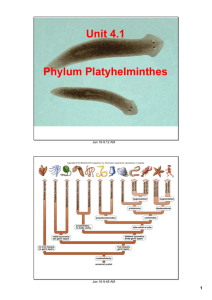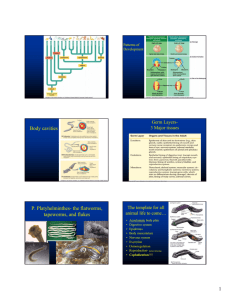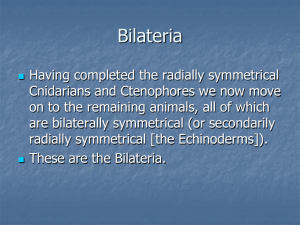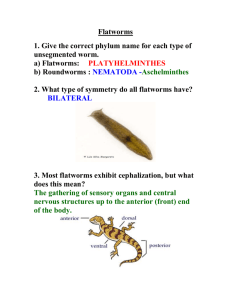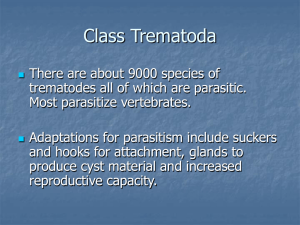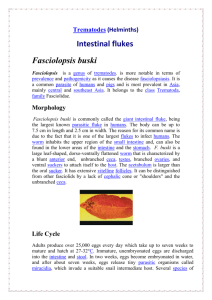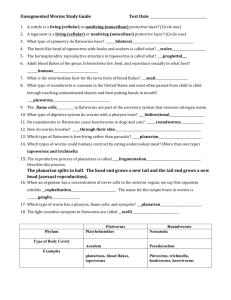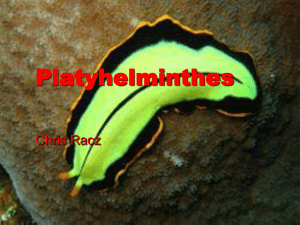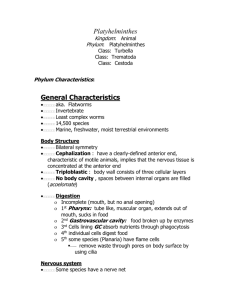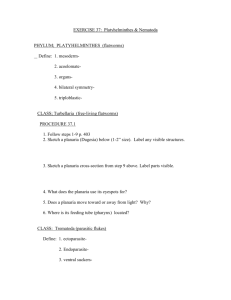Cercariae - Plattsburgh State Faculty and Research Web Sites
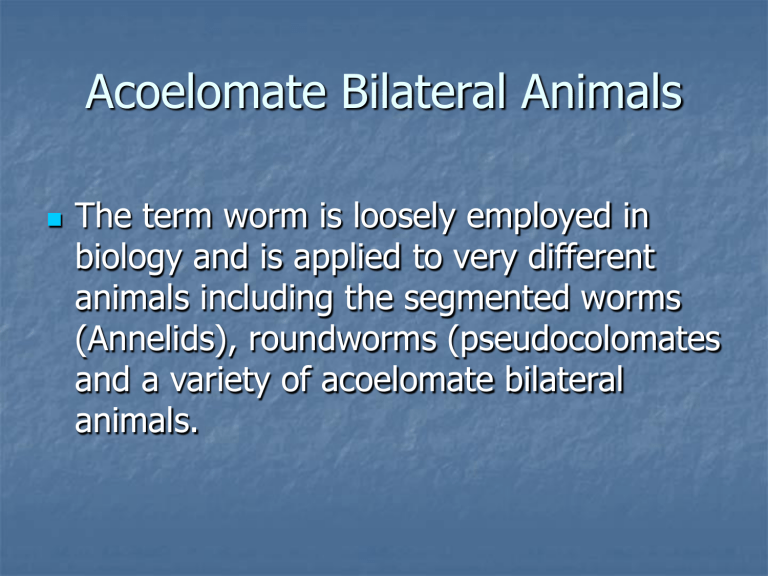
Acoelomate Bilateral Animals
The term worm is loosely employed in biology and is applied to very different animals including the segmented worms
(Annelids), roundworms (pseudocolomates and a variety of acoelomate bilateral animals.
Acoelomate Bilateral Animals
There are three phyla of acoelomate bilateral animals:
Platyhelminthes: flatworms
Nemertea: ribbon worms
Gnathostomulida: jawed worms
Acoelomate Bilateral Animals
By far the most important in diversity and economic importance is the phylum
Platyhelminthes, which includes a variety of parasitic forms such as the flukes and tapeworms.
Acoelomate Bilateral Animals
Unlike the radiate animals all of these organisms are mobile and have evolved cephalization with their sense organs concentrated at the head end. There is also the beginning of a laddertype nervous system.
In addition, they are bilaterally symmetrical.
Acoelomate Bilateral Animals
All of these animals are triploblastic, but lack a coelom. Instead, they have a solid body filled with parenchyma cells.
They have evolved organs and in some cases organ systems. The simplest excretory or osmoregulatory systems and circulatory systems are found in members of these groups.
Phylum Platyhelminthes
Members of the Platyhelminthes typically have dorsoventrally flattened bodies that are usually slender and leaflike or ribbonlike.
There are four classes in the Platyhelminthes.
The Turbellaria are free living whereas as members of the Monogenea, Trematoda and
Cestoda are parasitic.
Nutrition
The digestive system includes a mouth, pharynx, and blind intestine.
In the free-living Turbellarians the pharynx can be everted from the mouth.
Food is sucked into the intestine where a combination of extracellular and intracellular digestion takes place.
Nutrition
Undigested food exits via the pharynx.
In the Cestoda the digestive tract is absent and all nutrients are absorbed across the tegument (the syncytial membrane/body covering found in all parasitic Platyhelminthes).
Excretion/Osmoregulation
The osmoregulatory system consists of a series of canals that end in flame cells or protonephridia).
This system appears mainly intended to remove excess fluid, but retain essential ions. It is most well developed in freshwater Turbellarians, but reduced or absent in marine species, which do not have to remove excess water.
Nervous system and sense organs
Flatworms possess a simple brain and one to five pairs of longitudinal nerve cords that are cross connected to form a ladder-like arrangement.
There has been a tendency towards reduction of the number of pairs of nerve cords and increased development of the ventral pair. A similar evolutionary pathway may have led to the development of the ventral nerve cord found in annelids and arthropods.
Nervous system and sense organs
Neurons are specialized for different tasks e.g. sensory and motor functions, which is an important advance in the evolution of nervous systems.
There are a number of different sensory cells
(e.g. rheoceptors and statocysts) found in flatworms and tactile and chemoreceptive cells are abundant.
Nervous system and sense organs
In freshwater Planarians concentrations of sensory cells form two ear-like structures
(the auricles) found on the side of the head.
Light sensitive eyespots or ocelli are common in all classes but Cestoda.
Reproduction
Reproduction in the Platyhelminthes can be asexual or sexual. However, most are hermaphroditic and cross fertilize.
In parasitic forms sexual and asexual reproduction may alternate in different stages of the life history
Classification of Platyhelminthes
There are four classes in the
Platyhelminthes:
Class Turbellaria: free-living flatworms.
Class Turbellaria: endoparasitic flukes
Class Monogenea: parasitic flukes that are mainly ectoparasites
Class Cestoda: tapeworms
Class Turbellaria
Class Turbellaria contains about 3000 species.
There is considerable debate about the classification of the class and it is likely that the class is not monophyletic.
Most species are marine and benthic. However, some are also found in fresh water as well as in moist temperate and tropical terrestrial habitats.
Figure 14.10
8.2
Marine turbellarian
Dugesia tigrina , a freshwater turbellarian
© Mauricio A. Muñoz
Class Turbellaria
Most Turbellarians are predators of invertebrates smaller than themselves. Other species are herbivores or scavengers.
Turbellarians move by swimming, creeping or crawling. They combine muscular contractions with ciliary movement to move.
Class Trematoda
There are about 9000 species of trematodes all of which are parasitic.
Most parasitize vertebrates.
Adaptations for parasitism include suckers and hooks for attachment, glands to produce cyst material and increased reproductive capacity.
Sheep liver fluke
Class Trematoda
Structurally trematodes are similar to turbellarians having a well developed digestive system and similar nervous, excretory, and reproductive systems.
However, a major difference is the
tegument.
Tegument
The tegument (found in all parasitic
Platyhelminthes) is a nonciliated, cytoplasmic syncytium that overlays layers of muscle.
The syncytium represents extensions of cells that are located below the muscle in the parenchyma.
The tegument protects the parasite against its host (e.g. against digestive enzymes).
Figure 14.05
8.5
Digenean Trematodes
There are three subclasses of Trematodes, but two are small, poorly studied groups.
The third group, the Digenea, however is a large group of major medical and economic importance.
Digenean trematodes
The flukes have a complex life cycle in which a snail is the first (or intermediate) host and a vertebrate the final (or definitive host).
The definitive host is one in which the fluke reproduces sexually.
Digenean trematodes
In some species there may be 2 or 3 intermediate hosts before the definitive host is reached.
Trematodes inhabit a variety of sites in their hosts including the digestive tract, respiratory tract, circulatory system, urinary tract, and reproductive tract.
Digenean trematodes
Digenean life cycles are very complex and the fluke passes through numerous stages.
Digenean trematodes
A typical example would include the following stages:
Adult
Egg (or shelled embryo) shed into water
Miracidium: a free swimming, ciliated larva that finds and penetrates a snail intermediate host
Digenean trematodes
Sporocyst: reproduces asexually in intermediate host producing more sporocysts or another asexually reproducing stage called a redia.
Redia produce more redia or cercariae.
Cercariae leave the intermediate host and swim. Then they penetrate the skin of another intermediate host or the definitive host.
Digenean trematodes
Cercariae that enter an intermediate host encyst in muscle and wait to be consumed by the definitive host.
Cercariae that enter the definitive host make their way to their desired home and develop into an adult fluke which reproduces sexually and produces eggs.
Clonorchis
liver fluke
Clonorchis is the most important liver fluke to infect humans. Common in much of Asia (including China,
Japan and southern Asia).
Adult flukes live in the bile passages and shelled miricidia pass out in feces. The miricidia enter snails eventually leave the snails as cercariae and find a fish where they encyst.
If fish is eaten raw or poorly cooked the person becomes infected
Figure 14.12
8.8
How do flukes manipulate their hosts?
Many parasites infect an intermediate host that needs to be eaten by the definitive host for the parasite to complete its lifecycle.
There are many instances of parasites altering their intermediate hosts behavior to make it more vulnerable a predator (the definitive host).
Such behavior is widespread in flukes.
How do flukes manipulate their hosts?
In the Carpenteria Salt Marshes in southern California lives the fluke
Euhaplorchis californiensis.
It has a life cycle that includes two intermediate hosts, first the California
Horn Snail and then the California killifish and a final host which can be any of a variety of fish eating birds.
How do flukes manipulate their hosts?
The fluke leaves its definitive host as an egg in bird droppings which are eaten by the fluke’s first intermediate host the snail. snail host.
The fluke then castrates the snail (preventing it from diverting energy into eggs and away from the parasite).
The fluke then reproduces asexually and sheds cercariae into the water.
How do flukes manipulate their hosts?
The cercariae seek out the next intermediate host the killifish and latch onto the fish’s gills.
Each cercaria works its way into a blood vessel and explores until it finds a nerve which it then follows until it reaches the fish’s brain.
How do flukes manipulate their hosts?
The cercariae don’t penetrate the brain but sit on top of it. Then they wait for the fish to be eaten by a bird.
Once eaten by a bird they break out of the fish’s head and move into the bird’s gut where they produce eggs that continue the cycle
How do flukes manipulate their hosts?
The cercariae sitting on the bird’s brain apparently don’t sit passively waiting.
Killifish when swimming occasionally shimmy and jerk around flashing their bellies. Those infected with cercariae are four times more likely to do so than noninfected fish.
How do flukes manipulate their hosts?
In field experiments in which penned fish were made available to foraging birds infected fish were
30 times
(!) more likely to be eaten than uninfected fish.
How do flukes manipulate their hosts?
Research on how the flukes alter the fish’s behavior has shown that the flukes produce powerful molecular signals called fibroblast growth factors.
These interfere with the growth of nerves and may be the mechanism the flukes use.
Schistosomiasis
Schsitosomiasis is an infection with blood flukes and is one of the most important major infectious diseases on the planet.
More then 200 million people are infected worldwide with these flukes which they acquire swimming or walking in water in which the intermediate snail host lives
Schistosome life cycle.
Schistosomiasis
When a schistosome cercaria swims it takes care to avoid UV light which can damage it, but is very sensitive to the scent of humans.
When it senses molecules from human skin it swims rapidly and jerks around looking for the person. When it makes contact it releases chemicals that soften the skin and burrows in shedding its tail at the same time.
Schistosomiasis
The fluke searches until it finds a capillary and enters it.
The capillary is only barely wide enough for the fluke and it moves along using its pair of suckers. Eventually, it reaches a larger blood vessel in which it can float until it reaches the lungs and enters an artery and eventually makes its way to the liver.
Schistosomiasis
Once in the liver, the fluke feeds on blood and begins to mature and develops ovaries or testes depending on its sex.
The fluke grows dozens of times larger in the course of a few weeks and then begins to search for a mate.
Schistosomiasis
The fluke produces chemicals to attract members of the opposite sex.
Females are slender and delicate, whereas males are much bigger and have a spiny trough or groove into which the female fits and locks in.
Figure 14.13
8.9a and b
Schistosomiasis
Once paired up the pair mature sexually and travel from the liver to a permanent home that is species-specific.
In
Schistosoma mansoni
large intestine, in bladder, and in
S. nasale,
cows, it is the nose.
it is near the
S. haemotobium
it is the a blood fluke of
Schistosomiasis
Once established the pair remain in situ for the rest of their lives.
The male consumes blood and feeds the female most of it, which she turns into eggs, which pass out of the host and can begin the life cycle again.
Class Monogenea
The monogenetic flukes were previously classified as on order of the Trematoda, but recent work suggests they are more closely related to cestodes (tapeworms).
Monogeneans are typically external parasites of fish that clamp onto the gills using a hooked organ called an opisthaptor. Some also parasitize frogs and turtles.
Figure 14.16
8.11
Class Monogenea
Unlike the trematodes Monogeneans have only a single host.
The egg hatches into a ciliated larva which seeks out its host in the water.
Class Cestoda (tapeworms)
Tapeworms are parasites of the vertebrate digestive tract and about 4000 species of are known.
Almost all tapeworms require at least two hosts with the definitive host being a vertebrate although intermediate hosts can be invertebrates.
Class Cestoda
Members of the Class Cestoda (tapeworms) are quite different in appearance from the other members of the Platyhelminthes.
They have long, flat, tape-like bodies composed of a scolex for attaching to their host and a chain of many reproductive units or proglottids called a strobila. New proglottids form behind the scolex and the strobila may become extremely long.
Figure 14.18
8.12
Tapeworm scolex
Hooks
Suckers
The scolex is equipped with a combination of suckers and hooks that enable it to grip onto its host’s intestines.
Class Cestoda
Tapeworms live in the intestines and because they are immersed in digested food lack a digestive system of their own simply absorbing food across their tegument.
Class Cestoda
To facilitate the absorption of food a tapeworm’s tegument has huge numbers of tiny projections called microtriches, which are broadly similar to the microvilli of the vertebrate intestine.
They similarly increase the surface area of the tegument for absorption.
Figure 14.17
8.13
Class Cestoda
Tapeworms are usually monoecious (have both male and female reproductive organs).
A proglottid is fertilized by another proglottid in the same or a different strobila.
Shell-encased embryos form in the uterus and exit the proglottid via a uterine pore or the entire proglottid may detatch and pass out of the host.
Figure 14.20
8.14
Human tapeworms
Humans are definitive hosts to several tapeworms including the beef tapeworm
Taenia saginata
, pork tapeworm
T. solium
, and fish tapeworm
Diphyllobothrium latum
.
Human tapeworms
The lifecycles of these parasites are similar.
Shelled larave are shed into the environment.
These are consumed by the intermediate host and the larvae (oncospheres) hatch, bury into blood vessels and make their way to skeletal muscle where they encyst becoming so called
“bladder worms” or cysticerci.
Human tapeworms
The encysted larva develops an invaginated scolex and waits, perhaps for years, for its host to be eaten.
If the meat is uncooked the cysticercus extends its scolex, attaches to the wall of the intestine and within 2-3 weeks matures and begins growing and producing eggs. A tapeworm may be many meters long and live for years.
Figure 14.19
8.15
Humans as intermediate hosts
Humans may become intermediate hosts for tapeworms with potentially disastrous consequences if they consume shelled larvae in contaminated food.
In an evolutionarily unfamiliar environment, cysticerci may encyst in inappropriate locations such as the brain which is frequently fatal.
Figure 14.21
Cysticerci in human brain
8.16
Phylum Nemertea (Rhynchocoela)
Ribbonworms
The nemerteans (ribbon worms) are long, marine predatory worms and there are about 1000 species known.
Unlike members of the Platyhelminthes nemerteans have a complete gut with a mouth and anus and a true circulatory system
Phylum Nemertea (Rhynchocoela)
Ribbonworms
Prey is captured using a long muscular proboscis armed with a barb called a stylet..
The proboscis lies in an interior cavity called the rhynchocoel and muscular pressure on fluid in the rhynchocoel causes the proboscis to be quickly everted.
The prey is wrapped in the sticky, slime-covered, proboscis and stabbed repeatedly with the stylet.
Neurotoxins in the slime incapacitate the prey.
Figure 14.24a
8.18
Figure 14.24b
Internal structure of female ribbon worm
(above).
Nemertean with proboscis extended (right)
Figure 14.25
8.19
Baseodiscus mexicanus a nemertean from the Galapagos Islands
Phylum Gnathostomulida
The first Gnatostomulid was not discovered until 1928 and only about 80 species are known.
They are tiny (0.5-1mm long) wormlike animals that live in the interstitial spaces of sand and silt.
Phylum Gnathostomulida
Because they lack a pseudocoel, circulatory system, and anus gnathostomulids were first classed as turbellarians.
More recently it has been suggested that they are more closely related to the phyla
Rotifera and Acanthocephala.
Figure 14.27
8.20
Gnathostomula jenneri
